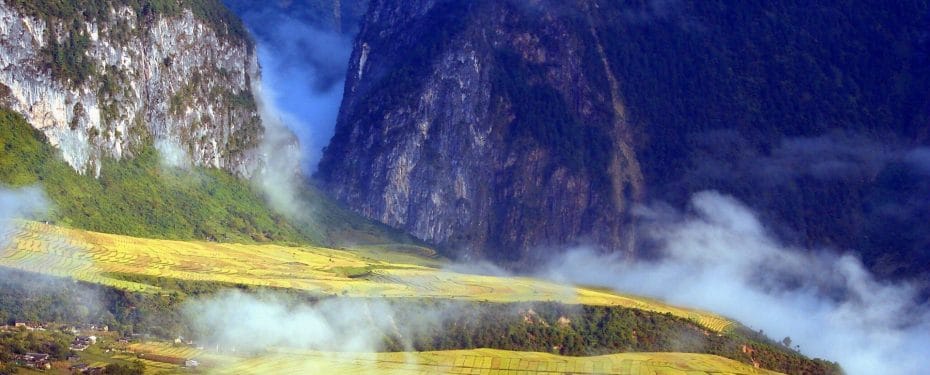Location:Nujiang, Yunnan
Bingzhongluo Scenic Area
920km from Kunming, something of a melting pot, Bingzhongluo represents the southernmost extent of the Tibetan culture, and the northernmost extent of Han Chinese influence in the valley. The local population includes Nu and Lisu people, as well as some Dulong. Even a Christian community exists, boasting a sizeable church down the hill from the town proper – but to get there you first have to pass by a Tibetan stupa.
Bingzhongluo is an excellent staging point for hikes west to the Dulong River, and east to the Mekong. You’ll definitely need a guide, however, as the mountains here are big and the weather severe. It’s possible to find guides in the area that speak rudimentary English, though you’ll be much better off if you can speak Chinese.
The most beautiful part of Nujiang Gorge starts from Binzhongluo. Bingzhongluo is another one-street town. It has a strong Tibetan flavor as most of the inhabitants around it are Tibetans and Nus and it is very close to Tibet itself. Immediately outside the main street to the east, small plots of farms spread out in terraces towards the river. There are more farms (mainly wheat) across the river on a beautiful peninsula jutting into the river- the Plum “Island”. The west of Bingzhongluo is backed by a few snow peaks.
Attractions in Bingzhongluo
There are easy and beautiful walks to nearby villages along the Nujiang. A few kilometers outside of town, the river widens and cuts through very deep and dramatic gorges. The road hugs the Nujiang and landslides occur from time to time along the way. It is said that the scenery is especially spectacular after rain, however this also increases potential delays and exacerbates the danger from landslides.
The most beautiful part of Nujiang Gorge starts from Binzhongluo, the northernmost town of the Gorge, where the essential attractions of the Nujiang Gorge are located. Hiking is the best way to enjoy the landscape and an average of 2.5 hours is needed for most tourists to reach the famous “Tea Horse Caravan Route.” Renting a mini bus at Bingzhongluo town is an alternative for the less adventurous sightseers.
On the way to the “Tea-Horse Caravan Route”, one can see the 100-year-old Zhongding Catholic Church built and founded by a French missionary. Shimen Pass is another fantastic section of the gorge along with Wengli (also called Wuli), another stunning landscape lying on a beautiful slope along the river bank. Very near to the Wengli, a carved path is seen on the other bank cliff, the so-called “Tea-Horse Caravan Route”, a path used by traders ferrying their goods between Yunnan and Tibet. At the end of the trekking road, an old hanging bridge and a new one-year-old bridge swing side-by-side.
To those wanderlusts, some trekking routes are worthy of spending days or even weeks longer between Gongshan and Bingzhongluo. Getting 90km further west to the Drung River from Gongshan reveal beautiful virgin forests as well as the kind-hearted Drung ethnic people living their old way of life.
There are easy and beautiful walks to nearby villages and along the Nujiang. A few kms outside of town, the river widens and cuts very deep and dramatic gorges. Villages on the other bank of the river are accessed either by narrow bridges constructed of small wooden planks/bamboo stringed together with rattan tied to trees; or by sliding on overhead cables that span the river. The cables are tied to trees on either side of the river and to cross, one is suspended and slide from a rope loop attached to a harness wear around the waist.
Call: (+86) 135 7702 4672 | Email: sales@travelchinawith.me
© Copyright 2012 - 2024, TravelChinaWith.Me | Hosting by ChemiCloud






